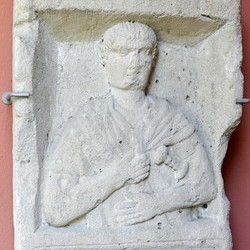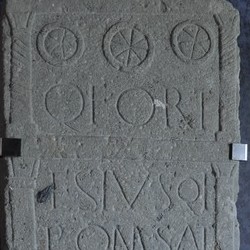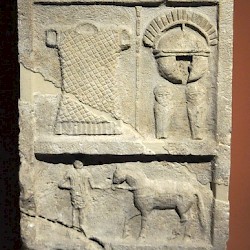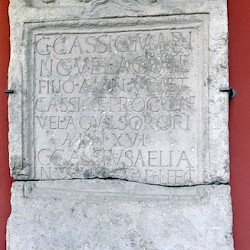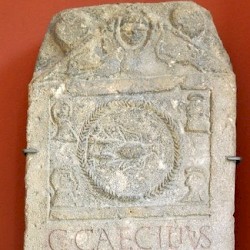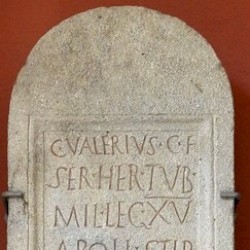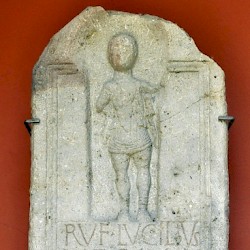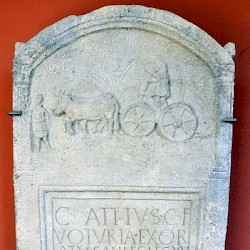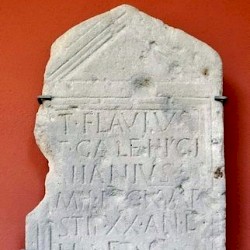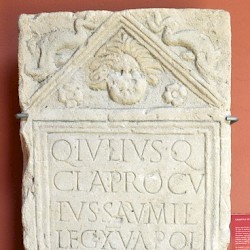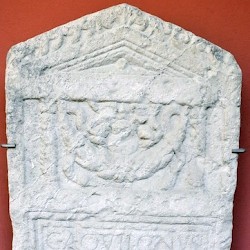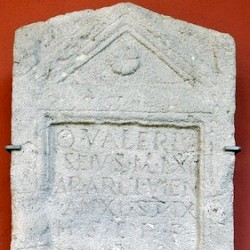Legio XV Apollinaris
Legio XV Apollinaris: one of the Roman legions. Its name signifies that it was dedicated to Apollo, the favorite god of the emperor Augustus.

Perhaps, this legion is identical to the Fifteenth Legion that Caesar recruited in 53 BCE, was trained by Titus Labienus, fought in Cisalpine Gaul against the Iapodes in 52, and was transferred to the Senate in 50. It stayed at Aquileia, and was sent by the Senate to Capua. When Caesar invaded Italy, the legion sided with the invader, who ordered it to occupy Africa. Here it was destroyed in the autumn of 49/48.
It is possible it was reconstituted immediately, but it is more probable that the Fifteenth Legion that was to be known as Apollinaris was founded in 41 or 40 by Julius Caesar's heir Octavian, who needed it to put an end to Sextus Pompeius' occupation of Sicily, which put the grain supply of Rome into peril. Octavian must also have chosen the surname Apollinaris, because he worshipped Apollo above all other gods.
When Pompeius was defeated (36), the Fifteenth was proably sent to Illyricum, where Octavian waged war in 35-33. Later, he and his fellow-triumvir Mark Antony started a war, which culminated in the naval battle off Actium (31), where Octavian defeated his opponent and won the supremacy in the Mediterranean world. From now on, he was known as the emperor Augustus.
After the battle of Actium, veterans were settled at Ateste, and the Fifteenth itself was sent to Illyricum, where it stayed for almost forty years - perhaps at Siscia or Emona (although there is no direct evidence for this) - unless it was active during Augustus' Cantabrian war.
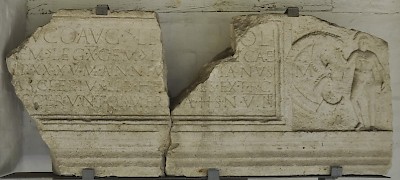
However this may be, in 6 CE, the fifteenth legion was certainly in Illyricum. In that year, Tiberius was to lead at least eight legions (VIII Augusta from Pannonia, XV Apollinaris and XX Valeria Victrix from Illyricum, XXI Rapax from Raetia, XIII Gemina, XIV Gemina and XVI Gallica from Germania Superior and an unknown unit) against king Maroboduus of the Marcomanni in Czechia; at the same time, I Germanica, V Alaudae, XVII, XVIII and XIX were to move against Czechia as well, attacking it along the Elbe. It was to be the most grandiose operation that was ever conducted by a Roman army, but a rebellion in Pannonia obstructed its execution. XV Apollinaris had its share of fighting during the repression of the revolt.
During the reshuffling of the Roman forces after the disaster in the Teutoburg Forest (September 9 CE), the legion was transferred to Ljubljana and/or Vindobona (modern Vienna) in Pannonia. When Augustus died in 14, its garrison town was probably already at Carnuntum (downstream from Vienna). When the soldiers arrived for the first time, this was still a native town; the legion made it a flourishing, thoroughly romanized city. Here, the legion stayed for some time.
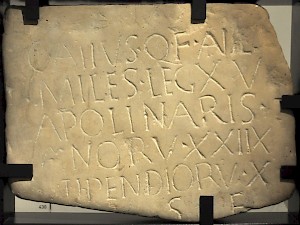
The emperor Nero's general Domitius Corbulo launched a campaign against the Parthian empire. Although the real fighting was done by III Gallica, IIII Scythica, VI Ferrata, X Fretensis and XII Fulminata, XV Apollinaris was also sent to Syria in 62 or 63, probably to guard the province or occupied newly-conquered Armenia. It was replaced at Carnuntum by X Gemina.
After the Parthian war, XV Apollinaris was stationed at Alexandria. But not for long. In 66, a new war broke out: this time, the Jews were the enemy. During the war that followed (more), XV Apollinaris, commanded by Vespasian's son Titus, played an important role. Among the towns it took, was Jotapata, where they captured the Jewish general Joseph, who was to become famous as the historian Flavius Josephus (67). The legion also took Gamala. Together with V Macedonica, it fought on the western front, whereas X Fretensis took care of the valley of the Jordan.
In 68-69, the war came to a standstill because Vespasian was recognized as emperor. He was to reign until 79. Titus resumed the war in 70 and captured Jerusalem (more). The winter of 70/71 was spent in Zeugma on the Euphrates, and in 71, the legion was shipped back to Carnuntum in Pannonia. On its way home, recruits from Cappadocia were added. When the soldiers arrived in Carnuntum, they rebuild their fortress.
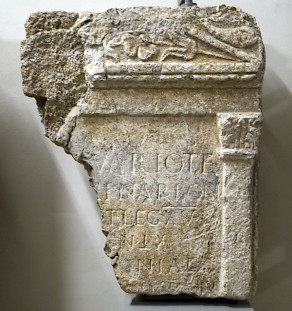
Subunits of XV Apollinaris took part in the Dacian wars of the emperors Domitian and Trajan. The Dacians had invaded the Roman empire in 86 and defeated the legions that were supposed to defend Moesia. In 88, a large Roman army group invaded Dacia and general Tettius defeated its king Decebalus at Tapae; the Fifteenth was one of nine legions involved. Unfortunately, the failed revolt of the governor of Germania Superior, Lucius Antonius Saturninus, in 89, prevented the ultimate success. Trajan was more successful, although the last Dacian wars still lasted five years (101-106). The result was the annexation of the country which is now known as Romania.
In 115, when war broke out between Rome and Parthia, XV Apollinaris was sent to the east and fought in Mesopotamia, where Trajan wanted to conquer the Parthian Empire. To make the legion more powerful, a subunit of XXX Ulpia Victrix was added to the Apollinarian legion. After initial successes like the conquest of Armenia, it became clear that this war could not be won. Trajan died as a broken man in 117 and was succeeded by Hadrian.
He reorganized the eastern frontier. The Fifteenth Legion was to remain in the east. Its base was was Satala in northeastern Cappadocia, seperated from the independent kingdom Armenia by the Upper Euphrates. Subunits were stationed permanently at Trapezus and Ancyra.
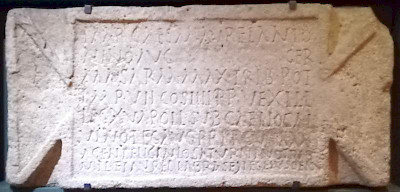
In 134, the Alans, a tribe from the steppes of Kazakhstan, threatened the Roman empire. The governor of Cappadocia, Arrian of Nicomedia, took XV Apollinaris and XII Fulminata into the field and defeated the invaders before they could become dangerous; he described this campaign in his Ektaxis.
In 162-166, it took part in the campaign of Lucius Verus against the Parthians. During this war, the Armenian capital Artaxata (south of modern Yerevan) was occupied by a mixed subunit of XII Fulminata and XV Apollinaris that was to stay there for some time. An inscription from Vagharshapat documents a subunit residing in Armenia during the reign of Commodus (r.180-192) and a damnatio memoriae during the reign of one of his successors.
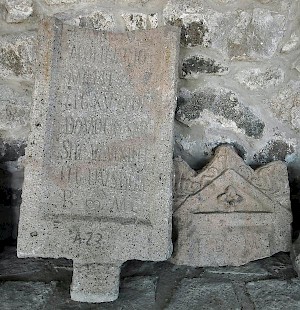
After the victory, the Fifteenth Legion returned to Satala, where it was still garrisoned in 175, when general Avidius Cassius revolted against the emperor Marcus Aurelius. The Fifteenth Legion, under Publius Martius Verus, refused to cooperate and remained loyal to the lawful ruler; therefore, it was awarded the title Pia Fidelis ("faithful and loyal"). The title may also have been earned in another way, by taking part in Marcus Aurelius' Germanic wars.
The Fifteenth Apollinarian Legion was still at Satala at the end of the second century and must have taken part in the Parthian campaigns of the emperor Lucius Septimius Severus (194 and 197-198), which culminated in the sack of the Parthian capital Ctesiphon.
The Fifteenth must have taken part in the expeditions of third century, like the one led by Severus' son Caracalla (217) and the war waged by Severus Alexander against the new, Sasanian Persian empire. The Sasanians had invaded the Roman empire in 230 and had installed an emperor in Emessa, but Severus Alexander was able to restore order and invade Mesopotamia. In 244, the Romans again invaded the country east of the Euphrates, but their emperor Gordian III died and was succeeded by Philippus Arabs, who owed his throne to the Sasanian king Shapur I.
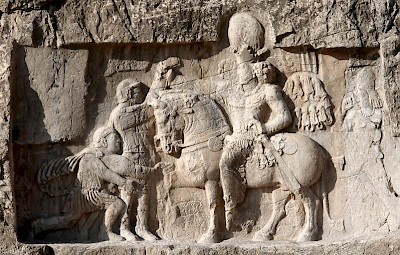
Even worse was to come, when the Persians invaded the Roman empire, captured Satala (256) and sacked Trapezus (258). When the Romans tried to strike back in 260, their emperor Valerian was captured. Captive Roman soldiers were ordered to build a bridge at modern Shushtar. The Roman defeats are commemorated on several Sasanian monuments.
However, under the emperors Odaenathus of Palmyra (261-267) and Diocletian (284-305), the Romans restored their fortunes and in 298, a peace treaty was concluded in which the Persians had to give up territories in northern Mesopotamia. The fifteenth legion must have played a role during these campaigns, but we have almost no information about them.
The only thing we know for certain that it was still at Satala at the beginning of the fifth century. By that time, however, Trapezus no longer belonged to its territories. It was guarded by I Pontica.
Its legionary emblem is unknown, but is unlikely to have been another picture than the god Apollo or, perhaps, one of the animals dedicated to this god, the griffin.
Literature
- M. Sasel Kos, "The Fifteenth Legion at Emona - Some Thoughts", in Zeitschrift für Papyrologie und Epigraphik 109 (1995), 227-244
- E. Wheeler, "Legio XV Apollinaris: From Carnuntum to Satala - and beyond", in: Yann Le Bohec, Les légions de Rome sous le Haut-Empire (2000 Lyon) 259-308
